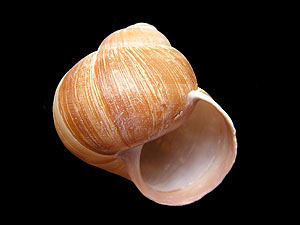
Most Roman snails' shells are coiled to the right. The aperture
(shell mouth) is right of the shell's longitudinal axis. [RN]
 Most Roman snails' shells are coiled to the right. The aperture (shell mouth) is right of the shell's longitudinal axis. [RN] |
Contrary to a snail's soft body is its hard resistant shell, which, other than the living body, is a lifeless construction. For a snail, its shell is of vital importance to its survival: On one hand, it means the only protection, when the snail withdraws into its shell. A certain part of a snail's body also always remains inside the shell. For the largest part, though, a Roman snail's shell is not firmly connected to the snail's body. The only place where both are connected is the main retractor or columellar muscle, which withdraws the snail into its shell.
Some important characters of a snail shell can be seen on first sight: In contrary to other molluscs' shells, such as a Nautilus's, a snail shell always is asymmetric. Around the longitudinal shell axis of a Roman snail shell, five to six whorls coil from the tip or apex to the shell mouth or aperture. The inner walls of those whorls form a hollow spire, the columella, at whose apical end the columellar muscle is attached.
The apertural rim of an adult Roman snail is folded back to form a whitish apertural lip. As only the adult snails can form such a lip, this is a way to know an adult snail shell from a juvenile one, juvenile snail shells always having a sharp apertural rim.
Size, colour and surface structure of a snail shell largely are species specific. Though there is a certain variation in each species' shells, most shells of Roman snails' relatives can be identified by shell characters with some certainty.
![]() The Way Snail Shells Are Coiled.
The Way Snail Shells Are Coiled.
![]() Scalariform Shells: This deformity is innocuous, but all the same, those
snails with an untypical elongate shell look quite conspicuous.
Scalariform Shells: This deformity is innocuous, but all the same, those
snails with an untypical elongate shell look quite conspicuous.
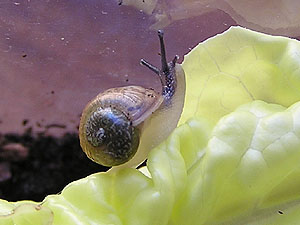 This juvenile Roman snail has but few whorls; its shell is soft and translucent, so the internal organs can be seen. [RN] |
A freshly hatched juvenile snail's shell only has about 1½ whorl. It is only few millimetres in diameter and so translucent, that the snail's internal organs can be seen from outside. Until it has reached maturity, a Roman snail shell will grow to almost ten times of its initial size. Also the shell walls are much thickened and opaque. That way the snail's shell grows together with its inhabitant, so the snail is optimally protected.
Chemically a Roman snail shell consists mainly of lime (calcium carbonate, CaCO3): If immersed in hydrochloric acid, the lime is dissolved, releasing carbon dioxide (CO2, which explains the bubbles forming, when you drip hydrochloric acid on a limestone – a common petrologic test). However, there is also an organic residue of a substance that is not dissolved by acid. While most of the shell consists of calcium carbonate, its surface is covered by a organic skin, the periostracum to protect it against the corrosive effects of the environment.
Only with a microscope's high magnification the shell wall structure of several layers of prism shape lime crystals becomes visible. Those crystals are arranged so they overlap each other, so the shell achieves maximal stability. This shell layer, which by far makes the largest part of the shell's cross-section, is called the ostracum. There are some molluscs, mainly bivalves, that possess a third shell layer that, located below the other layers, is called hypostracum, better known as mother-of-pearl.
Snails are not able to produce calcium carbonate themselves; they have to take it in with their food or by another way. That means that calcium carbonate is extracted from the food during digestion, but it can also be obtained directly from the ground. To do so, a Roman snail will rest on a lime-rich surface, acidify the slime under its sole by releasing carbon dioxide into it and then dissolve lime directly from the ground.
Obtained from the food, calcium carbonate will be stored mainly in the main digestive gland (or hepatopancreas), in small amounts also in the albumen gland. When it is needed, then it is transported in a dissolved state, as calcium and carbonate ions, for example to shell-producing cells dispersed over the mantle surface.
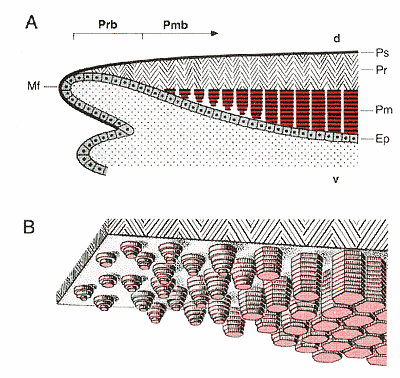 Growth of a (bivalve) mollusc's shell: A: Schematic longitudinal cut through the area of shell growth. B: Three-dimensio- nal view of wall growth. Prb: Ostracum growth; Pmb: Hypostracum growth. Ps: Pe- riostracum; Pr: Ostracum; Pm: Hypostracum; Ep: Pallial epithelium. d: dorsal; v: ventral. Source: Wehner, Gehring: Zoologie (1995). |
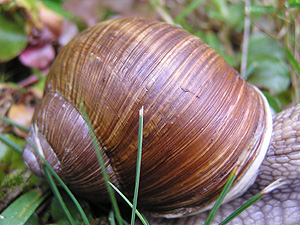 This Roman snail's shell clearly shows growth stripes, that that show us one day's shell growth. [RN] |
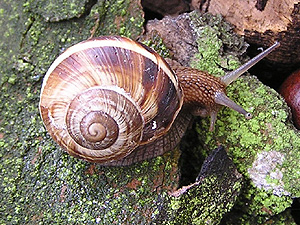 This juvenile Helix lucorum shows clearly visible growth discon- tinuities in its dark shell bands. [RN] |
The shell's growth in size exclusively takes place near the shell mouth. Here there are mantle folds with numerous layers of gland cells. The inner layer of gland cells produces the shell matter that will make the largest part of the shell, the ostracum. From outside, one layer of gland cells covers the ostracum with a shell skin. Further to the inside, dispersed gland cells thicken the shell wall by attaching shell matter from inside. That way, the shell grows together with its inhabitant, in size and in thickness.
On a Roman snail's shell, the growth stripes can easily be seen. They show us, how much the snail had grown in one day. With some certainty it is also possible to calculate the age, when the snail became mature, because then the growth of a snail's shell ends with the construction of the apertural lip (see below). The growth stripes also give us information on how well the snail was supplied with food, as then it grows faster and so the growth stripe becomes wider.
Other snail's shells, such as that of the Turkish snail (Helix lucorum), can show growth discontinuities. Among Central European snails this may happen because a snail stops growing during winter. The Turkish snail, however, does not hibernate. Here those discontinuities, visible as lighter areas in the dark shell bands, happen during growth stops during dry periods, when the snail aestivates dug in the ground.
As already described, a Roman snail's shell not only grows in mere size, but also in thickness. Like in a mussel calcium carbonate crystals are attached on the inside of the shell as mother-of-pearl (an iridescent form of aragonite, a calcium carbonate mineral), a Roman snail also has gland cells dispersed over the mantle surface. Those, though, produce a lime-rich substance that hardens without structure and thickens the shell wall. Additionally those gland cells also can be used to repair shell damages (see below).
With the snail's maturity also ends the growth of its shell. The apertural rim then folds back and forms a lip finishing the formerly sharp-edged rim. This apertural lip, as already mentioned, makes it possible to tell a juvenile shell from an adult one.
The connection between maturity and the end of shell growth can clearly be seen in a disease, during which the snail's hermaphroditic gland – the gonad – is destroyed by a parasite. The hermaphroditic gland, on the other hand, is responsible for the snail's sexual maturity, which is why parasitically castrated snails never reach it. As a consequence, the snail's growth never ends: Parasitically castrated Roman snails are considerably larger than healthy one, but they lack the apertural lip.
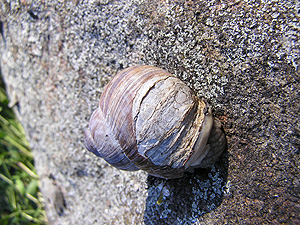 A Roman snail with a damaged shell it later repaired. [RN] |
Most Roman snails had to suffer shell damage at some time of their life, be it by accident or by the attack of one of the many enemies. Provided the snail survives this, the shell shows repaired places, which are clearly different from the remainder of the shell surface.
There are in fact gland cells dispersed over the mantle surface that produce shell matter. But this is structure-less and whitish in colour. As the shell skin, the periostracum, is only formed near the shell aperture, it is missing in these repaired places, they show the granular structure of the shell mater and no colour like that of the remaining shell.
Only during longitudinal shell growth it is possible to repair the whole cross-section of the shell including the shell skin. After completion of the shell lip, only the shell itself, not its skin, can be reconstructed.
Apart from shell damages from natural causes, there may also be shell deformities, that need not necessarily be harmful to the snail: